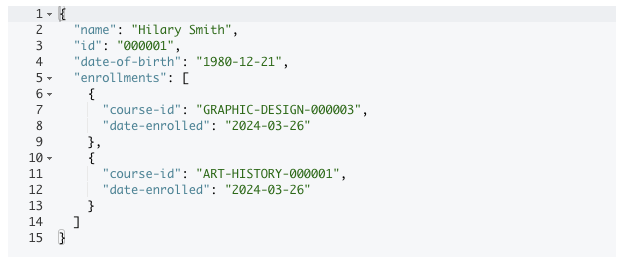Add Course Enrollments
- tutorial
Add enrollment information to the student records using the Couchbase SDK.
Add Enrollment Details
To add enrollment details to a student record:
-
In your
javadirectory, create a new file calledAddEnrollments.java. -
Paste the following code block into your
AddEnrollments.javafile:import com.couchbase.client.core.error.CouchbaseException; import com.couchbase.client.java.Bucket; import com.couchbase.client.java.Cluster; import com.couchbase.client.java.Collection; import com.couchbase.client.java.Scope; import com.couchbase.client.java.json.JsonArray; import com.couchbase.client.java.json.JsonObject; import com.couchbase.client.java.query.QueryOptions; import com.couchbase.client.java.query.QueryResult; import com.couchbase.client.java.query.QueryScanConsistency; import java.time.Duration; import java.time.LocalDate; import java.time.format.DateTimeFormatter; public class AddEnrollments { public static void main(String[] args) { // Calls `Cluster.connect` to create a channel to the named server and supplies your username and password to authenticate the connection. Cluster cluster = Cluster.connect("localhost", "username", "password"); // Retrieves the bucket you set up when you installed Couchbase Server. Bucket bucket = cluster.bucket("student-bucket"); // Forces the application to wait until the bucket is ready. bucket.waitUntilReady(Duration.ofSeconds(10)); // Retrieves the `art-school-scope` collection from the scope. Scope scope = bucket.scope("art-school-scope"); Collection student_records = scope.collection("student-record-collection"); // Retrieves Hilary's student record, the `graphic design` course record, and the `art history` course record. // Each method uses a SQL++ call to retrieve a single record from each collection. JsonObject hilary = retrieveStudent(cluster,"Hilary Smith"); JsonObject graphic_design = retrieveCourse(cluster, "graphic design"); JsonObject art_history = retrieveCourse(cluster, "art history"); // Couchbase does not have a native date type, so the common practice is to store dates as strings. String currentDate = LocalDate.now().format(DateTimeFormatter.ISO_DATE); // Stores the `enrollments` inside the student record as an array. // `JsonArray.create()` creates an empty list structure. JsonArray enrollments = JsonArray.create(); // Adds two JSON elements to the `enrollments` array: the course that the enrollment relates to, and the date that the student enrolled in the course. // To avoid repeating data all over the cluster, you store a reference to the course instead of the entire course record itself in this field. // This means that you do not have to search through every single record if the course details change. enrollments.add(JsonObject.create() .put("course-id", graphic_design.getString("id")) .put("date-enrolled", currentDate)); enrollments.add(JsonObject.create() .put("course-id", art_history.getString("id")) .put("date-enrolled", currentDate)); // Adds the `enrollments` array to Hilary's student record. hilary.put("enrollments", enrollments); // Commits the changes to the collection. // The `upsert` function call takes the key of the record you want to insert or update and the record itself as parameters. // If the `upsert` call finds a document with a matching ID in the collection, it updates the document. // If there is no matching ID, it creates a new document. student_records.upsert(hilary.getString("id"), hilary); cluster.disconnect(); } private static JsonObject retrieveStudent(Cluster cluster, String name) throws CouchbaseException { QueryOptions studentQueryOptions = QueryOptions.queryOptions(); studentQueryOptions.parameters(JsonObject.create().put("name", name)); studentQueryOptions.scanConsistency(QueryScanConsistency.REQUEST_PLUS); final QueryResult result = cluster.query("select META().id, src.* " + "from `student-bucket`.`art-school-scope`.`student-record-collection` src " + "where src.`name` = $name", studentQueryOptions); return result.rowsAsObject().get(0); } private static JsonObject retrieveCourse(Cluster cluster, String course) throws CouchbaseException { QueryOptions courseQueryOptions = QueryOptions.queryOptions(); courseQueryOptions.parameters(JsonObject.create().put("courseName", course)); courseQueryOptions.scanConsistency(QueryScanConsistency.REQUEST_PLUS); final QueryResult result = cluster.query("select META().id, crc.* " + "from `student-bucket`.`art-school-scope`.`course-record-collection` crc " + "where crc.`course-name` = $courseName", courseQueryOptions); return result.rowsAsObject().get(0); } }Because this is a tutorial, you do not need to add an error check to make sure that your collection has returned an item. In a live application, though, error checks must be made to prevent errors and keep the application running. -
Open a terminal window and navigate to your
studentdirectory. -
Run the command
mvn installto pull in all the dependencies and rebuild your application. -
Run the following command to insert the student record into the collection:
mvn exec:java -Dexec.mainClass="AddEnrollments" -Dexec.cleanupDaemonThreads=false -
Go to your Couchbase cluster in your browser.
-
Go to the
student-record-collectionand click the Edit icon or the document ID to see the new information you just added to Hilary’s student record.
If you come across errors in your console, see the troubleshooting page.
Next Steps
Now that you have finished following the Student Record System tutorial, you can explore more of Couchbase by checking out the rest of the developer documentation.